Table of Content
During festivals in India, individuals adhere to numerous traditions and customs. Someone is creating a Rangoli design, which is an Indian traditional art form, on the floor next to the entrance. During specific events like Holi, Diwali, weddings, prayers, and various celebrations, individuals create uncomplicated rangoli patterns in their yards to adorn their house and greet their gods and guests.
Rangoli is a form of art that involves creating floor patterns using different materials like colored sand, flowers, dried wheat, and so on. The vibrant sand rangoli patterns easily catch our attention. The importance of rangolis in our culture varies. It scatters the negative energy that a person carries. As you walk through geometric patterns at the front of the house, you feel a sense of pleasant energy when entering. The lovely patterns at the doorway will inspire you all day long before heading off to work in the AM.
Creating uncomplicated and effortless rangoli patterns is believed to bring luck and prosperity to the household and its residents. Colorful rangolis are adored by people all over the country. They not only serve to invite Goddess Lakshmi but also represent the happiness, positivity, and liveliness of a household. Different names are used to refer to Rangolis, like Alpana in Bengal, Kolam in Tamilnadu, and Chowk Pujan in Bihar and Madhya Pradesh.
Simple & Easy Rangoli Designs
A home that lacks a clean entryway and vibrant, simple rangoli designs is believed to bring bad luck. Rangolis have functions beyond just decoration, providing an attractive appearance to indoor spaces.
Creating basic rangoli designs is easy for some people, but not everyone finds it simple. Patience, hard work, and outstanding creative skills are essential. A spacious courtyard is also essential for making attractive, vibrant, uncomplicated, and manageable rangoli patterns.
Here are some uncomplicated and effortless rangoli patterns you can experiment with during this festive season.
1. Geometric Rangoli Design - Easy Rangoli Design
Are you in search of a minimalistic rangoli pattern that can also enhance the aesthetic appeal of your house? If so, then this easy geometric rangoli pattern is perfect for you! Simply create these quadrilaterals and squares and select the appropriate combination of colors to enhance the beauty of your rangoli pattern. Make sure to mark the edges using either white chalk or tiny piles of powder dots, which will enhance the individual shapes while giving the overall design a finished look.
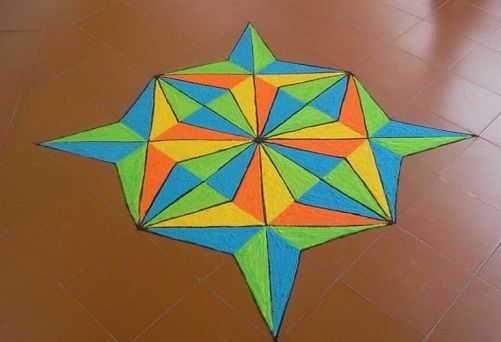

2. Lord Ganpati Simple Rangoli Design
Prior to beginning any task, we typically ask for the blessings of Lord Ganesha. As rangoli is created during special events, it is recommended to create a Ganpati rangoli pattern. Here is an easy rangoli pattern that you can make at home or office using vibrant rangoli colors. The Ganesha rangoli pattern is a well-liked choice among rangoli designs.

.jpg)
3. Peacock Rangoli Design
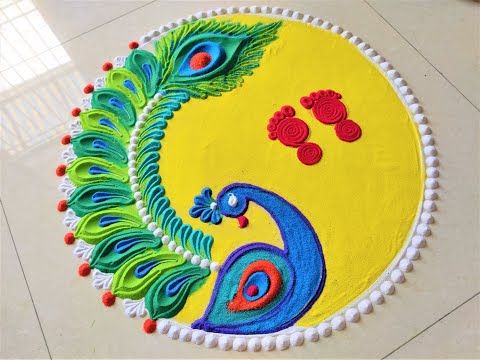
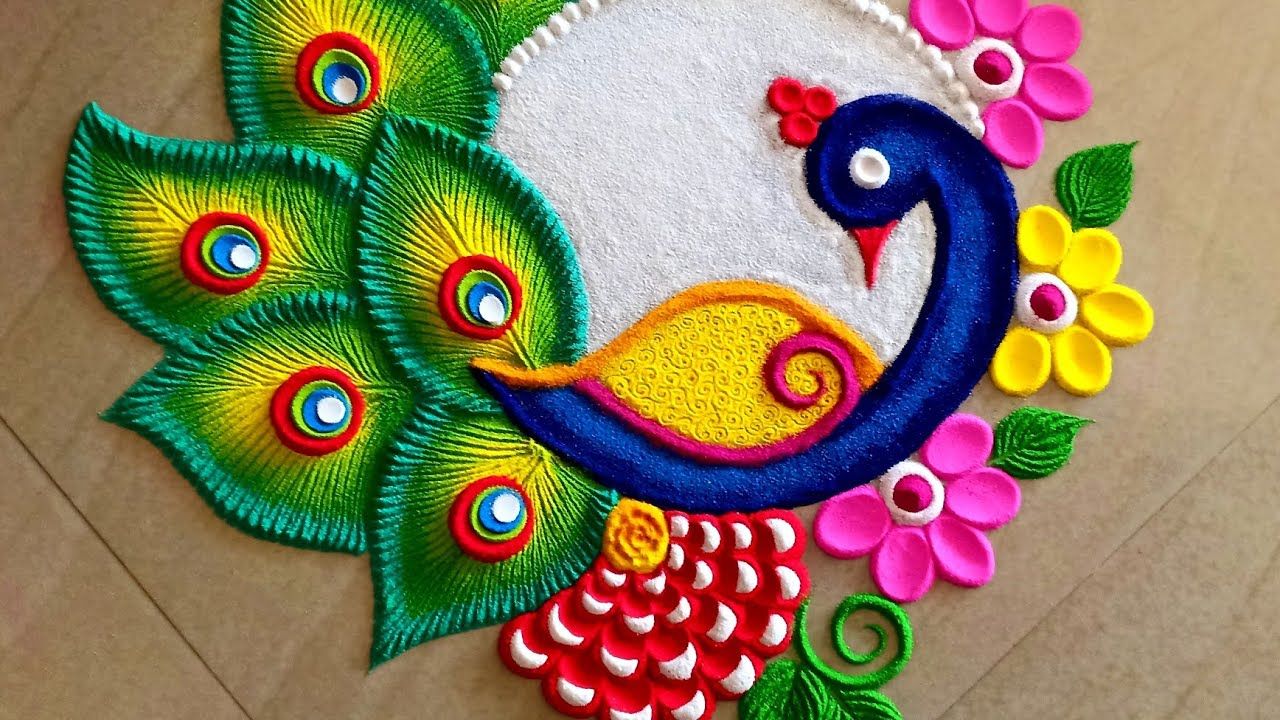
4. Easy Rangoli Design With Chalk
A chowk purn is a simple and easy rangoli design found in India. Elderly women continue to create designs to welcome guests and for special ceremonies such as the Chhath pooja, Styanarayan Katha, and Gangour. Chawk is extremely fortunate and is believed to be favored by all the gods and goddesses. It is made with wheat flour, vermilion, and turmeric.
.jpg)
.jpg)
5. Easy Rangoli Design with Flower Petals
This is a modern and uncomplicated rangoli pattern made with beautiful flower petals. The petals of the flowers appear visually appealing, complemented by the fragrant smell of flowers such as roses, marigolds, and lotuses. Flower petal rangolis are commonly observed during the Onam Pookalam festivities in Kerala.


6. Rangoli Design With Quilling
Quilling is the sole material used for creating paper-based Rangolis. Quilling involves the authentic craft of slicing lovely paper into lengthy, slender strips or shaping pieces by rolling and pinching.
.jpg)
.jpg)
7. Easy Rangoli Design Using Finger
Creating this rangoli design is very simple and straightforward. Simply create a pleasing foundation of colors. Both blend two hues together as shown in the picture below. Alternatively, you could divide it evenly in half, or opt for a combination of 3 or 4 different colors. If you prefer a straightforward and fast approach, opt for a single color foundation. Example a vibrant orange or crimson. Next, employ your finger to form the desired pattern. It could be a diya, a ganpati, a geometric design, etc. You can also choose to embellish it with scattered flower petals if desired. And just like that, your rangoli is complete!
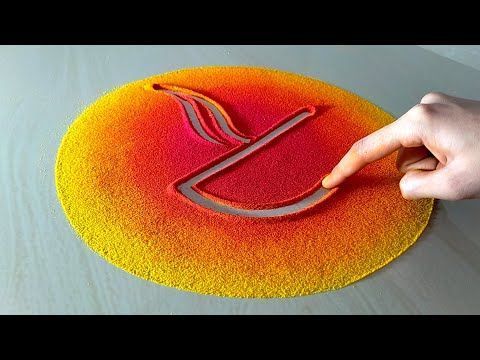
.jpg)
8. Simple Rangoli Designs On Water
Water rangolis are the newest and modern form. Individuals utilize candles, flowers, and diyas placed on the water to create these patterns. Watercolours continue to be utilized in the present day, and they continue to create a beautiful appearance. The powder used on the ground is the same colour as the one used to create this design. Fill a jar with water, drop some oil in, then create your design within.
.jpg)
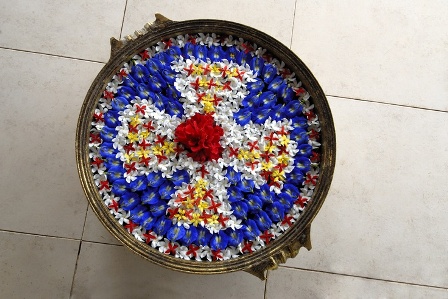
9. Easy Rangoli Designs With Pulses
This is another simple rangoli pattern that you can create during the festive season. A pulse rangoli is the sole rangoli made up of edible grains. Kidney beans, green moong dal, yellow moong dal, cheerios, rice, wheat, split peas, etc. are the grains that provide the rangoli with its vibrant colors.

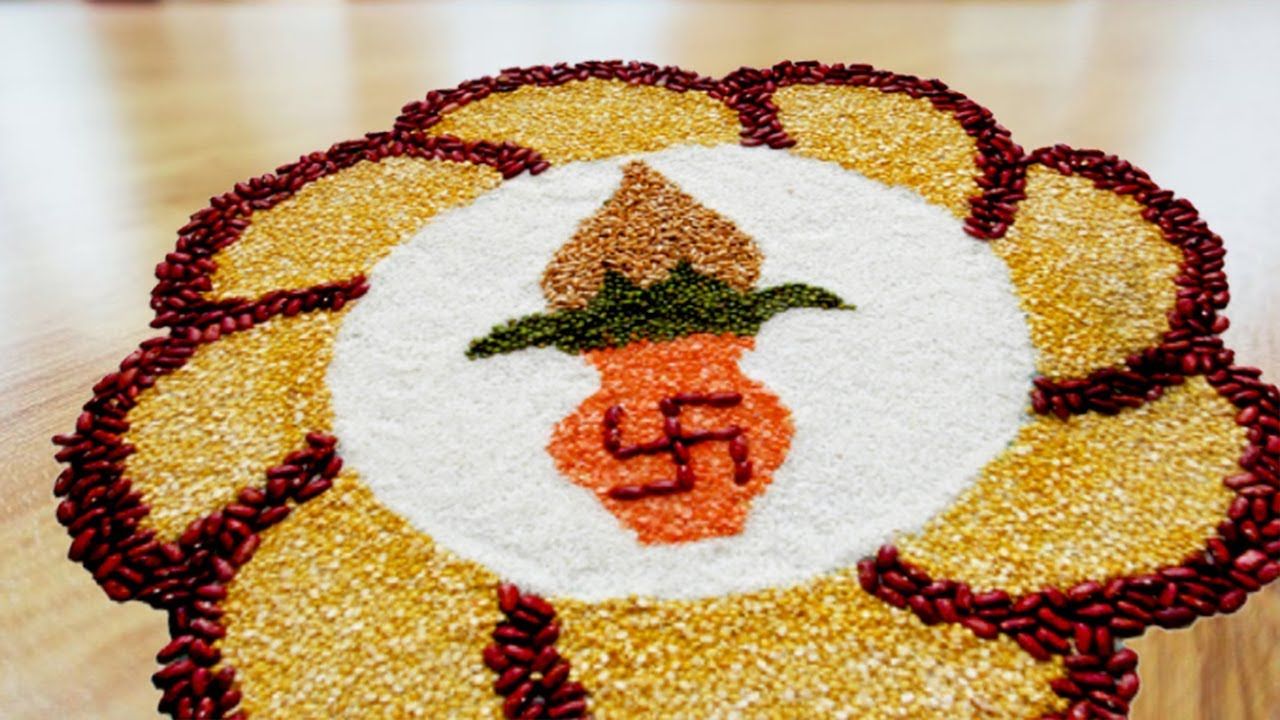
10. Round Colourful Kolam Rangoli Design
Kolam rangoli patterns possess a unique allure that enhances the festive atmosphere. Employ a variety of vibrant hues to craft a classic kolam rangoli pattern. When created for celebrations, this evokes positive energy, unity, and abundance.
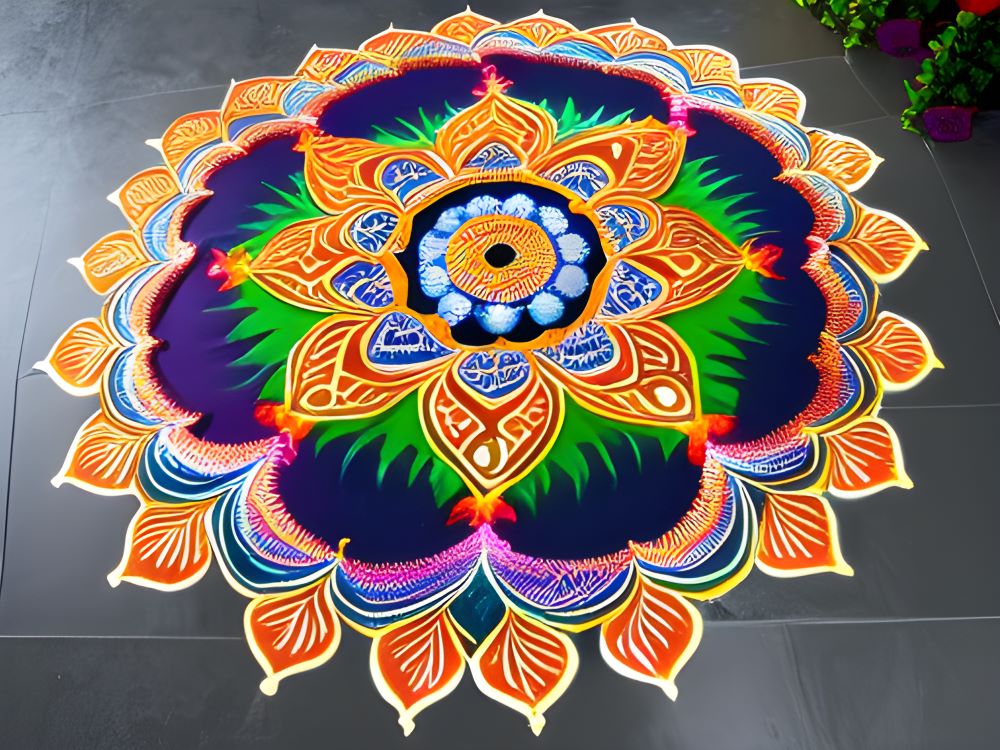
Types of Easy Rangoli Designs
Dotted rangoli - While there are various intricate and complex styles of rangoli, the dotted ones are the most charming and uncomplicated. To create the design, a grid with the correct amount of dots must be used. Among beginners, this rangoli design is known for being uncomplicated and easy to create. Dots are used to create images of animals like the lotus, peacock, and tortoise. With dots, various shapes like squares, circles, and stars can be formed. Afterwards, you can add colors in beautiful shades to make it look appealing.
Also Read: Rangoli
Form rangoli - The most common rangoli shapes are cones, circles and lines.
Ornamental rangoli - typically includes deities, petals, birds, flowers, animals, and trees as decorative elements. The central image usually includes a Swastika, moon, conch or sun. Adding two curved lines in the middle of the two parallel lines produces the illusion of a pair of serpents. One of the eight petals of the lotus represents the Sun, Lord Vishnu, and the eight cardinal directions of the universe. The lotus in India symbolizes fertility and is associated with the goddess Laxmi.
Summing Up Easy Rangoli Designs
The terms 'Rang' and 'Aavali,' when combined, signify 'row of colours,' and serve as the basis for the term rangoli. Typically, rangoli patterns are made using colored chalk, rice flour, and crushed limestone. Rangoli patterns and colors vary greatly depending on the regions, customs, and lifestyles of the people.
Rangolis serve the purpose of beautifying your home decor and warding off evil energies. Therefore, choose a few of these simple rangoli patterns for decorating your courtyard and attracting positivity during this festive season.
Also Read: 10 New False Ceiling Designs - to Make Your Home Stand out

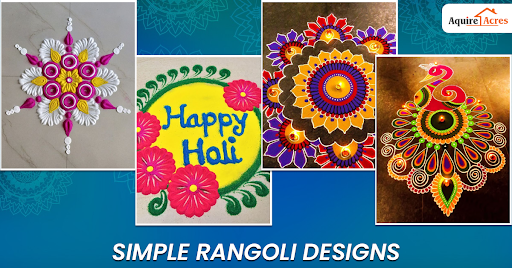

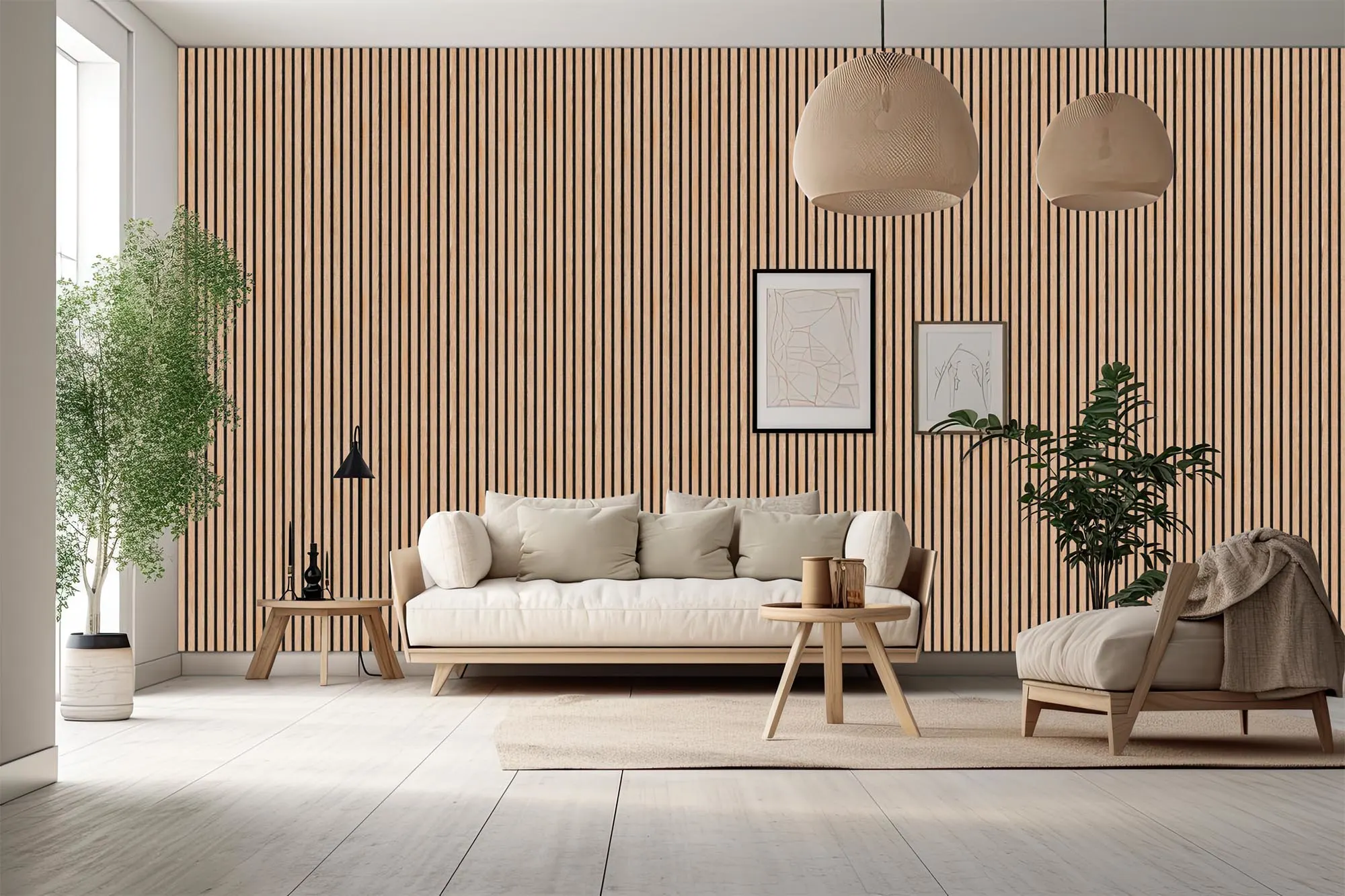



_1767164061.webp)


Ans 1. Draw your design outline in chalk on the floor.If you are not making your Rangoli on black paper, you will need to draw a basic outline on the floor, or wherever you are creating your Rangoli. Draw the outline in thin, light chalk lines. Draw the chalk outline lightly just in case you need to erase any mistakes.
Ans 2. Traditionally, Rangoli is an art of decoration drawn on the floor or the entrances of homes. It is thought to bring good luck, prosperity on the house and in the family, and to welcome guests. Some mothers in India do this activity every morning, or on a special festive occasion like Diwali, Onam, and Pongal.
Ans 3. For our design we place 2 cups of rice into 6 different Ziploc bags, using a total of 12 cups of rice. In each bag we added 2 teaspoons of liquid food coloring. Seal the bag and shake the rice until the rice is evenly covered. Empty rice on paper plates to dry.
Ans 4. Pink made using Ganganagari Rose Petals & Beetroot.Green made using Indigo, Alfa-Alfa, Mewar Turmeric & Lemon Grass.Orange made using Ganganagari Rose Petals & Beetroot & Mewar Turmeric.Yellow made using Palash Flowers & Mewar Turmeric.
Ans 5. If you mix red and blue, you are sure to get purple.
Ans 6. You can design a rangoli on a dry surface inside or outside the house. The home entrance and pooja room are the right places to design a rangoli on festive occasions.